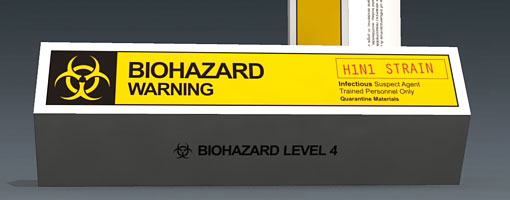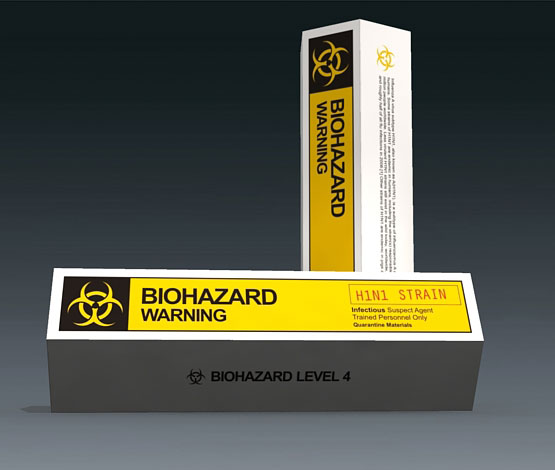
This model is fictitious virus container. Influenza A virus subtype H1N1, also known as A(H1N1), is a subtype of influenzavirus A and the most common cause of influenza (flu) in humans. Some strains of H1N1 are endemic in humans, including the strain(s) responsible for the 1918 flu pandemic which killed 50–100 million people worldwide. Less virulent H1N1 strains still exist in the wild today, worldwide, causing a large fraction of all seasonal influenza and roughly half of all flu infections in 2006. Other strains of H1N1 are endemic in pigs and in birds. [Wikipedia]

In March and April 2009, an outbreak of H1N1 influenza in Mexico led to hundreds of confirmed cases and a number of deaths. As of April 28, the new strain was suspected to have infected more than 2,500 individuals worldwide, with 152 attributed deaths. The U.S. Centers for Disease Control and Prevention warned that it was possible the outbreak could develop into a pandemic. On April 27, 2009, the World Health Organization raised their alertness level from 3 to 4 (on a scale of 6) worldwide in response to sustained human-to-human transfer of the virus. The situation was raised to level 5 (pandemic imminent) on April 29, 2009 by the World Health Organization. [Wikipedia]

SWINE FLU
The swine influenza virus isolated from patients in the United States was found to be made up of genetic elements from four different flu viruses – North American Mexican influenza, North American avian influenza, human influenza, and swine influenza virus typically found in Asia and Europe – "an unusually mongrelised mix of genetic sequences." This new strain appears to be a result of reassortment of human influenza and swine influenza viruses, in all four different strains of subtype H1N1. However, as the virus has not yet been isolated in animals to date and also for historical naming reasons, the World Organisation for Animal Health (OIE) suggests it be called "North-American influenza". On April 30, 2009 the World Health Organization began referring to the outbreak as "Influenza A (H1N1)" instead of "swine flu", presumably to countermand the consequences of the misleading less scientifically labeled name as referenced by WHO spokesperson Dick Thompson.
Several complete genome sequences for U.S. flu cases were rapidly made available through the Global Initiative on Sharing Avian Influenza Data (GISAID). Preliminary genetic characterization found that the hemagglutinin (HA) gene was similar to that of swine flu viruses present in U.S. pigs since 1999, but the neuraminidase (NA) and matrix protein (M) genes resembled versions present in European swine flu isolates. The six genes from American swine flu are themselves mixtures of swine flu, bird flu, and human flu viruses. While viruses with this genetic makeup had not previously been found to be circulating in humans or pigs, there is no formal national surveillance system to determine what viruses are circulating in pigs in the U.S. [Wikipedia]
Document license
You may freely distribute or give away these paper models to others without prior permission from the designer, you may modify with the credit to paper-replika.com. Feel free to add any of these paper models to your website or blog, with the link to paper-replika.com model pages. Do not use direct link. Uploading to mass file storage for public view is forbidden, including, but not limited to, rapidshare, mediafire and others which provide similar service. All images are copyrighted. Permission is granted ONLY for non-commercial personal use. They may not be duplicated in any form, including electronic, mechanical or printed, for sale. All rights are reserved and duplication by any means,including, but not limited to, methods of printing, electronic storage and disk copies, is prohibited without permission. If you wish to use this artwork and instructions for other than your own personal use, like for a club contest or school program,PLEASE contact paper-replika.com for written permission.
This work is licensed under a
Creative Commons Attribution-NonCommercial-ShareAlike 3.0 Unported License.

No Warranty is provided whatsoever. This material is provided on an as-is basis with no support and no warranty. All real life objects belong to its respective owners and designers.
This pattern never been tested, some minor errors were found in several of previuos models, please be advise maybe you will find errors such as missing tabs or unnecessary tabs, despite the models never been tested, many have succeeded build all of them perfectly, just need little imagination and dedication to this hobby.
To download this file you DO NOT NEED to be registered as a member, Registration whatsoever needed to join paper-replika.com FORUM and to give comments on articles. Paper-replika.com NEVER share your identity or sale to third party, and it will be kept safe.
We use third-party advertising companies to serve ads when you visit our website. These companies may use information (not including your name, address, email address, or telephone number) about your visits to this and other websites in order to provide advertisements about goods and services of interest to you. If you would like more information about this practice and to know your choices about not having this information used by these companies, click here.PASSWORD : paper-replika.com (case sensitive)
Open PDF file with Adobe Acrobat Reader, PDO with Pepakura Viewer.
The assembly instruction is not include with the file that you are about to download. You can find the assembly instructions of this model with just go back and browse previous page.
Agree and download
H1N1 Virus Container template